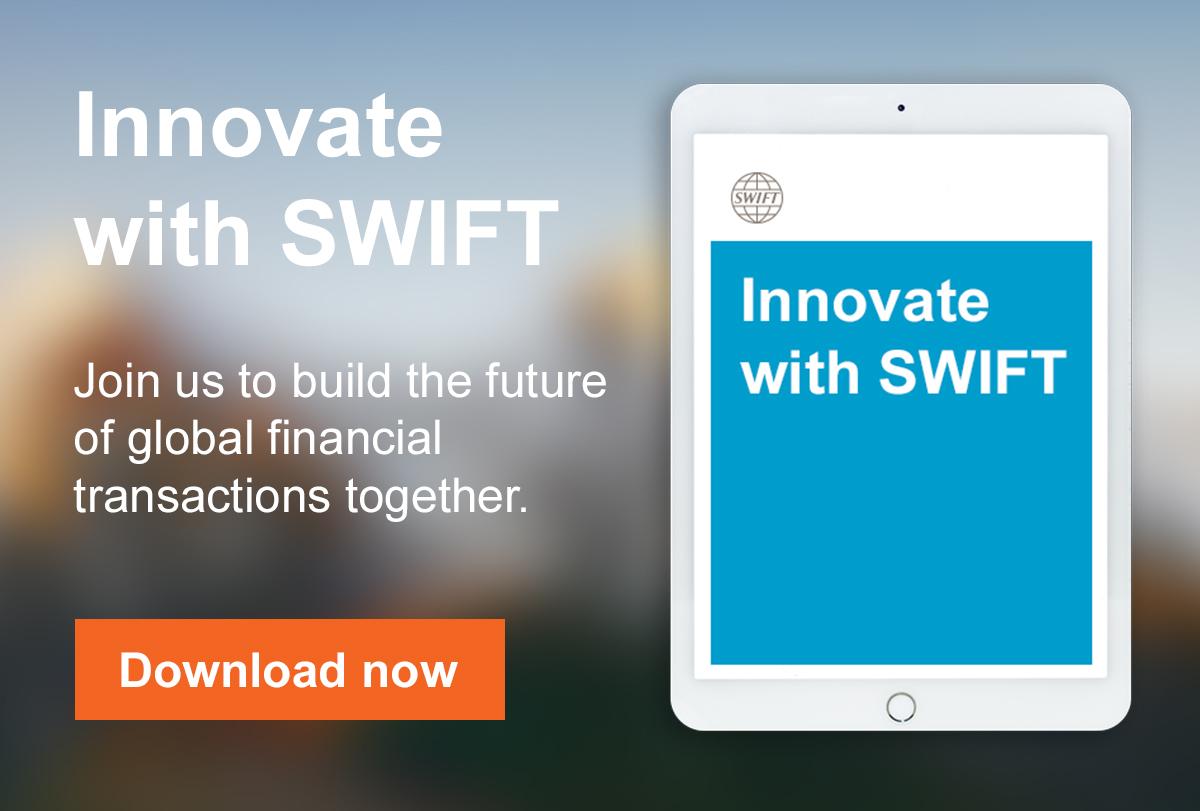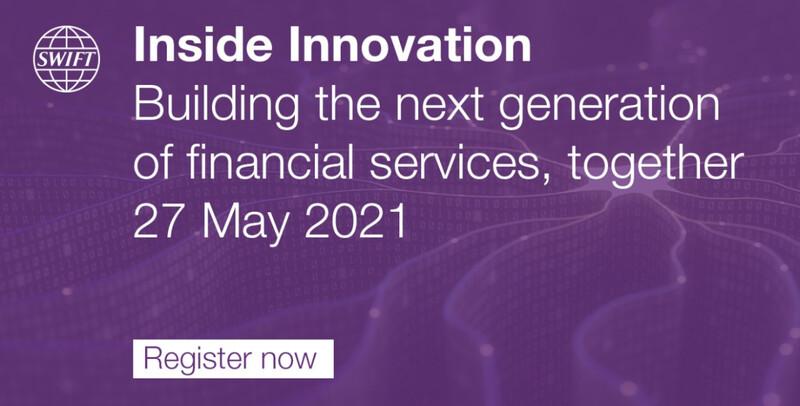How can financial institutions convert their innovation efforts into effective solutions for customers? What are the ingredients of successful collaboration and what can we learn from past projects? Sean Sarginson, Global Head of Innovation at Swift, answers these questions and more.
Following our previous article on the challenges of innovation, we sat down with Sean Sarginson, Global Head of Innovation at Swift, to dive deeper into the topic of collaboration within financial services. In our conversation, we discuss why collaborative innovation is necessary, how working together in a post-pandemic world has changed, and look at the next big opportunities to deliver exceptional services to customers.
Why is collaboration between financial institutions so important?
The financial services ecosystem depends on collaboration in the same way that life on earth depends on the planet’s atmosphere. For Swift, establishing the right collaboration models within the banking community has been essential for the industry to reach where it is today. The real trick is clearly defining the customer or business outcome, then working out which collaboration tools and approaches are best suited to meet that goal. Is it a challenge that can be solved by working one-on-one with a visionary institution or do we need more seats at the table?
Swift plays a central role in bringing different institutions together to explore new solutions. Through industry-wide collaboration, we’re able to develop solutions that mutualise costs and drive a far greater change than individual institutions could do alone. And collaboration can take many forms. For example, we recently partnered with the Bank of International Settlements to organise a hackathon exploring the benefits of ISO 20022 in cross-border payments, and worked with RegTech player Suade Labs on streamlining liquidity reporting, to name just two.
However, innovating successfully is not a simple task. It requires a high level of coordination and for everyone to be pointed in the same direction. Typically when innovating, you’re only as fast as your slowest mover, which is why we’re also keen to work with smaller focus groups to develop a good understanding of the problem we’re trying to solve, before opening it up to the rest of the community for feedback. By combining design thinking with lean product development we can bring a solution to market much faster and create something that can then be scaled-up to benefit the rest of the industry, while still allowing institutions to evolve at their own pace.
How has the pandemic changed the way we collaborate?
One of the most important parts of creating a new solution is to truly understand your customer – their needs, the jobs they carry out on a daily basis and what kind of solution might help solve the problem they’re having. This comes way before thinking about the technicalities of what you’re building.
Usually this understanding comes after focused workshops with stakeholders and one-to-one interviews with end users. The inability to be in the same physical room as our customers at the moment has definitely been something that’s taken time to get used to, but it hasn’t stopped us from moving forward. No two customers are the same, so we’ve had to find new ways of working with each new project. With the move towards digital, it’s also been really important to be disciplined in how you run sessions – ensuring they have real structure and are outcome-led has been essential to maintaining momentum.
On a more macro level, one thing the pandemic has definitely highlighted is just how interconnected our world is. And a lesson I think we can all take away, not just in financial services, is the need to work together to tackle global challenges.
What are the biggest success factors for collaborative innovation?
Successful innovation requires a number of different things to work. You need a strong cross-functional team of the right people, executive buy-in, budget, the ability to scale your solution to the community and a path to production from day one. There’s no point finalising your plan only to discover your product delivery team doesn’t have capacity to execute because they’ve already got too much on their plate.
You’ve got to understand your customer too – who suffers from this problem and how will your solution make their life easier? It’s about working out what your biggest risks are and validating or invalidating them as soon as possible to de-risk your approach.
And, ultimately, it’s about being prepared to drastically change your plans if you need to. Innovation rarely follows a straight line. It’s a winding road with twists and turns and you need to be comfortable with seeing where each of them go, even if you didn’t originally plan to.
What are some examples of recent successful collaborations?
Many examples spring to mind – for example, Swift GPI. We wanted to transform cross-border payments. Make them faster, more transparent and develop common Service Level Agreements (SLAs) that all participating banks would adhere to.
It was crucial that we had a good understanding of the problem we were trying to solve, so we worked with key figures within the cross-border payment chain to understand the main issues and opportunities for development. Next, we brought together 15 banks from around the world to form a working group. The aim of this was to ensure that the problems we had identified in our research were grounded in reality, and resonated with banks that sent payments on daily basis. Finally, we began testing and implementing our solution. We created a Unique End-to-end Transaction Reference (UETR) in the payment message, allowing it to be fully trackable wherever it is in the chain. Today, Swift GPI is used by over 4,000 financial institutions that send the equivalent of more than USD 400 billion in value via the service every day, with most payments made in minutes and nearly all within a day.
Our recent project to streamline customer migrations to Alliance Cloud is also worth mentioning. At our annual Swift Operations Forum Europe (SOFE) in 2019, we listened to our users about the difficulty of migrating from Alliance Access or Lite2 to Alliance Cloud. They told us that reconfiguring payment rules required a lot of manual input and could have pretty big consequences if you got it wrong – i.e. sending money to the wrong person.
We ran workshops with the product delivery team, one-to-one interviews with users and partnered with our customer experience teams to automate this process, giving customers peace of mind while reducing cost and risk in their cloud migration journey. In this scenario, working one-on-one meant we were able to move fast and scale up our solution to the rest of the community, while saving a significant amount of time and money. It’s different to the way we tackled Swift GPI, but illustrates that there’s no one-size-fits-all approach to collaboration.
What are the next big opportunities for collaborative innovation in financial services?
The next two years are going to be really exciting with the launch of Swift’s next-generation platform. Our enhanced platform will transform the world of payments and securities by facilitating instant and frictionless cross-border transactions. It will also offer a huge opportunity for new partnerships and collaborations through the use of APIs and cloud technology.
We’re developing a common set of services with our customers to help reduce the cost and risk of innovating – services that have traditionally been invested in by institutions individually. On top of this, we are encouraging our community to co-create new products with us to spur on the overall level of service our end-customers receive.
Fully harnessing the power of APIs is another big opportunity. APIs allow different platforms to talk to each other and facilitate the creation of new products and services through the secure but open exchange of data. A great example is the way that Uber integrates with Google Maps. Uber hasn’t had to go out and collect its own map data to work out how to get from A to B, or gather its own traffic data to determine how long a journey will take during rush hour. Instead, it plugs into Google Maps and is able to use all that information in a way that it wasn’t originally designed for, to deliver a whole new product for a fraction of what it would cost to start from scratch.
We’ve seen other industries use APIs to deliver vastly improved user experiences, and there’s a lot of potential to use them more effectively within financial services too. Open Banking is a good example and has many use cases – allowing financial institutions secure access to customers’ bank statements to support loan or mortgage application, or provide the ability for a customer to view all of their bank accounts in one app despite them being with multiple institutions. Realising the potential of API technology within our industry could make it possible to explore new avenues that previously wouldn’t have been possible.
The reality is that nobody is going to single-handedly find the answers to some of the industry’s biggest challenges. But, if we take an evidence-based approach and focus wholly on our end-customers’ experience, there is the potential for us to build some great things together.





